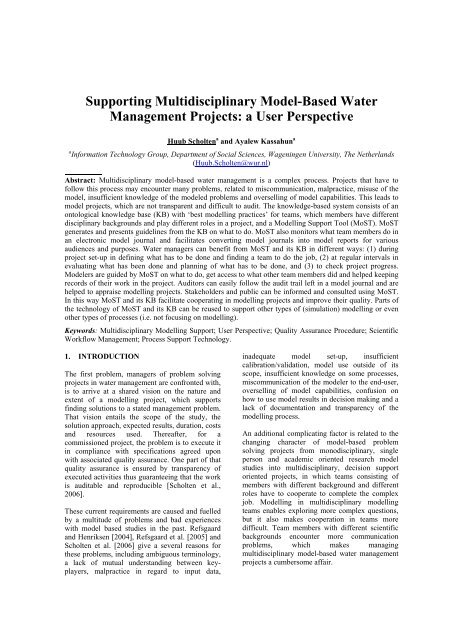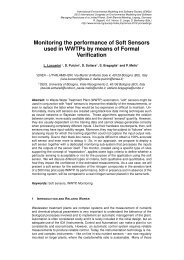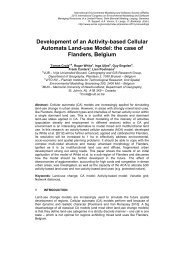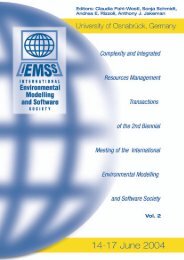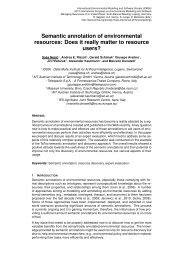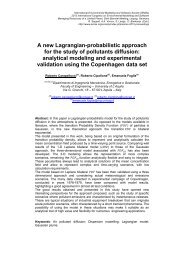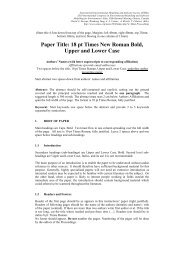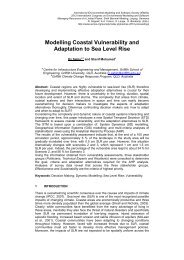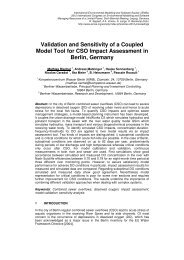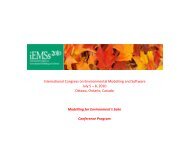Supporting multidisciplinary model-based water management projects
Supporting multidisciplinary model-based water management projects
Supporting multidisciplinary model-based water management projects
You also want an ePaper? Increase the reach of your titles
YUMPU automatically turns print PDFs into web optimized ePapers that Google loves.
<strong>Supporting</strong> Multidisciplinary Model-Based Water<br />
Management Projects: a User Perspective<br />
Huub Scholten a and Ayalew Kassahun a<br />
a Information Technology Group, Department of Social Sciences, Wageningen University, The Netherlands<br />
(Huub.Scholten@wur.nl)<br />
Abstract: Multidisciplinary <strong>model</strong>-<strong>based</strong> <strong>water</strong> <strong>management</strong> is a complex process. Projects that have to<br />
follow this process may encounter many problems, related to miscommunication, malpractice, misuse of the<br />
<strong>model</strong>, insufficient knowledge of the <strong>model</strong>ed problems and overselling of <strong>model</strong> capabilities. This leads to<br />
<strong>model</strong> <strong>projects</strong>, which are not transparent and difficult to audit. The knowledge-<strong>based</strong> system consists of an<br />
ontological knowledge base (KB) with ‘best <strong>model</strong>ling practices’ for teams, which members have different<br />
disciplinary backgrounds and play different roles in a project, and a Modelling Support Tool (MoST). MoST<br />
generates and presents guidelines from the KB on what to do. MoST also monitors what team members do in<br />
an electronic <strong>model</strong> journal and facilitates converting <strong>model</strong> journals into <strong>model</strong> reports for various<br />
audiences and purposes. Water managers can benefit from MoST and its KB in different ways: (1) during<br />
project set-up in defining what has to be done and finding a team to do the job, (2) at regular intervals in<br />
evaluating what has been done and planning of what has to be done, and (3) to check project progress.<br />
Modelers are guided by MoST on what to do, get access to what other team members did and helped keeping<br />
records of their work in the project. Auditors can easily follow the audit trail left in a <strong>model</strong> journal and are<br />
helped to appraise <strong>model</strong>ling <strong>projects</strong>. Stakeholders and public can be informed and consulted using MoST.<br />
In this way MoST and its KB facilitate cooperating in <strong>model</strong>ling <strong>projects</strong> and improve their quality. Parts of<br />
the technology of MoST and its KB can be reused to support other types of (simulation) <strong>model</strong>ling or even<br />
other types of processes (i.e. not focusing on <strong>model</strong>ling).<br />
Keywords: Multidisciplinary Modelling Support; User Perspective; Quality Assurance Procedure; Scientific<br />
Workflow Management; Process Support Technology.<br />
1. INTRODUCTION<br />
The first problem, managers of problem solving<br />
<strong>projects</strong> in <strong>water</strong> <strong>management</strong> are confronted with,<br />
is to arrive at a shared vision on the nature and<br />
extent of a <strong>model</strong>ling project, which supports<br />
finding solutions to a stated <strong>management</strong> problem.<br />
That vision entails the scope of the study, the<br />
solution approach, expected results, duration, costs<br />
and resources used. Thereafter, for a<br />
commissioned project, the problem is to execute it<br />
in compliance with specifications agreed upon<br />
with associated quality assurance. One part of that<br />
quality assurance is ensured by transparency of<br />
executed activities thus guaranteeing that the work<br />
is auditable and reproducible [Scholten et al.,<br />
2006].<br />
These current requirements are caused and fuelled<br />
by a multitude of problems and bad experiences<br />
with <strong>model</strong> <strong>based</strong> studies in the past. Refsgaard<br />
and Henriksen [2004], Refsgaard et al. [2005] and<br />
Scholten et al. [2006] give a several reasons for<br />
these problems, including ambiguous terminology,<br />
a lack of mutual understanding between keyplayers,<br />
malpractice in regard to input data,<br />
inadequate <strong>model</strong> set-up, insufficient<br />
calibration/validation, <strong>model</strong> use outside of its<br />
scope, insufficient knowledge on some processes,<br />
miscommunication of the <strong>model</strong>er to the end-user,<br />
overselling of <strong>model</strong> capabilities, confusion on<br />
how to use <strong>model</strong> results in decision making and a<br />
lack of documentation and transparency of the<br />
<strong>model</strong>ling process.<br />
An additional complicating factor is related to the<br />
changing character of <strong>model</strong>-<strong>based</strong> problem<br />
solving <strong>projects</strong> from monodisciplinary, single<br />
person and academic oriented research <strong>model</strong><br />
studies into <strong>multidisciplinary</strong>, decision support<br />
oriented <strong>projects</strong>, in which teams consisting of<br />
members with different background and different<br />
roles have to cooperate to complete the complex<br />
job. Modelling in <strong>multidisciplinary</strong> <strong>model</strong>ling<br />
teams enables exploring more complex questions,<br />
but it also makes cooperation in teams more<br />
difficult. Team members with different scientific<br />
backgrounds encounter more communication<br />
problems, which makes managing<br />
<strong>multidisciplinary</strong> <strong>model</strong>-<strong>based</strong> <strong>water</strong> <strong>management</strong><br />
<strong>projects</strong> a cumbersome affair.
The European Commission funded HarmoniQuA<br />
project aimed at lowering many of the hurdles<br />
encountered in present simulation oriented<br />
<strong>model</strong>ling by providing <strong>model</strong>ling guidelines,<br />
structured in a knowledge base and by developing<br />
a tool to support <strong>projects</strong> that use <strong>model</strong>s for<br />
problem solving [HarmoniQuA, 2006]. The<br />
context of the HarmoniQuA project, which<br />
involves 12 partners in 10 countries and 10<br />
different languages, introduced new problems.<br />
These were partly associated with language issues,<br />
which were beyond the scope of the project as<br />
professional <strong>model</strong>ers were assumed to understand<br />
sufficiently English, and partly because of the<br />
variety of <strong>model</strong>ling cultures in various countries<br />
ranging from very professional and mature in<br />
northwest Europe to novel and ad hoc in some<br />
central and south European countries. These<br />
discrepancies in expertise were further enhanced<br />
by the level of maturity of the scientific disciplines<br />
behind the <strong>water</strong> domain <strong>model</strong>s, ranging from<br />
very mature for ground<strong>water</strong> <strong>model</strong>ling to<br />
immature for ecological and socio-economic<br />
<strong>model</strong>s [Refsgaard et al., 2005].<br />
This paper focuses on how the results of<br />
HarmoniQuA’s Modelling Support Tool, MoST,<br />
and its associated knowledge base with guidelines<br />
help solving some of the outlined problems. The<br />
tool, the knowledge base and the technology, on<br />
which these are <strong>based</strong>, are discussed from a user<br />
perspective.<br />
2. MODELLING SUPPORT<br />
To support and facilitate the work of<br />
<strong>multidisciplinary</strong> teams and its project manager in<br />
<strong>model</strong>-<strong>based</strong> <strong>water</strong> <strong>management</strong> the following<br />
approach has been chosen. The <strong>model</strong>ling process<br />
has been described and decomposed into elements.<br />
The overall process is decomposed into steps,<br />
steps into tasks and tasks into activities.<br />
Furthermore, methods/tools can be coupled to<br />
tasks or to activities. Tasks are related to each<br />
other with precedence relations, determining the<br />
order of tasks and feedback loops to redo parts of<br />
the process, if necessary. There are three types of<br />
tasks: (ordinary) tasks, decision tasks and review<br />
tasks. Decision tasks have feedbacks to previous<br />
tasks and review tasks are decision tasks in which<br />
teams discuss progress and decide on continuation.<br />
Finally, many details on steps, tasks and activities<br />
can be added to the knowledgebase. That means<br />
that a generic <strong>model</strong> of a <strong>model</strong>ling process has<br />
been developed. Based on this decomposition and<br />
experiences with other processes, an ontological<br />
knowledge base (KB) has been designed with<br />
levels of increasing specialization (see Figure 1):<br />
• level 0: meta-ontology with basic<br />
terminology;<br />
• level 1: generic process knowledge;<br />
• level 2: <strong>model</strong>ling knowledge;<br />
• level 3: knowledge for <strong>model</strong>-<strong>based</strong> <strong>water</strong><br />
<strong>management</strong>.<br />
This leveled structure of the ontological<br />
knowledge base facilitates reusing parts of it: a<br />
more generic/abstract level can easier be reused<br />
for other purposes.<br />
The KB has been implemented in Protégé, a<br />
powerful, state-of-the-art, open source ontology<br />
editor and knowledge base framework.<br />
meta-ontology<br />
(level 0)<br />
uses<br />
generic process<br />
ontology<br />
(level 1)<br />
<strong>model</strong>ling process<br />
instance<br />
(level 2)<br />
is_a_specialization_of<br />
is_a_specialization_of<br />
<strong>model</strong>ling process<br />
instance for <strong>water</strong><br />
<strong>management</strong> (level 3)<br />
generic<br />
specialized<br />
Figure 1. A stepwise ontology specialization<br />
representing the structure of the knowledge base.<br />
To fill the KB with generic <strong>model</strong>ling knowledge<br />
and <strong>water</strong> domain specific knowledge, a (web<br />
<strong>based</strong>) KB-Editor has been developed, which acts<br />
as front-end between domain experts, unskilled in<br />
knowledge engineering, and the knowledge base<br />
implemented in Protégé. The KB and the KB-<br />
Editor are the backbone of the Knowledge-Based<br />
System (KBS) and will be discussed in another<br />
contribution to this conference.<br />
Other major components of the KBS are the<br />
Modelling Support Tool (MoST) and training<br />
material. MoST helps a project manager to filter<br />
pieces of <strong>model</strong>ling knowledge from the KB that<br />
are relevant for a specific project and the problem<br />
at hand. In this way the project manager arrives at<br />
a specification of the work to be done, by whom<br />
(experts with different disciplinary background)<br />
and using what other resources (<strong>model</strong>s, tools).<br />
Subsequently, in the execution phase of the<br />
project, MoST monitors what all team members do<br />
and helps generating ‘smart’ reports for various<br />
audiences and purposes. Finally, training material<br />
has been developed consisting of written material,
presentations, exercises that encourage using<br />
MoST in a training test case project and many<br />
screen-recording movies on MoST, its knowledge<br />
base, a case study and some background<br />
information. The movies are the core part of the<br />
training material and aim at helping users to work<br />
with MoST and act as a sort of animated help<br />
facility. Elements of the training material are used<br />
in the Help System. MoST, its KB, the KB-Editor,<br />
the Training Material and the Help System form an<br />
integrated product to support <strong>multidisciplinary</strong><br />
<strong>model</strong>-<strong>based</strong> <strong>water</strong> <strong>management</strong> <strong>projects</strong>.<br />
MoST can be optimally used in a setting, in which<br />
a (distributed) team, consisting of problem owner /<br />
(<strong>water</strong>) manager, <strong>model</strong>er(s), auditor, stakeholders<br />
and interested members of the public cooperate in<br />
a <strong>multidisciplinary</strong> <strong>model</strong>-<strong>based</strong> <strong>water</strong><br />
<strong>management</strong> project (i.e. covering more than one<br />
<strong>water</strong> <strong>management</strong> domain). What team members<br />
do is stored in a <strong>model</strong> journal. The <strong>model</strong> journal<br />
is shared by all team members and stored on a<br />
project server (on Internet or on a LAN). A server<br />
application is responsible for managing <strong>model</strong><br />
journals, enabling that all team members see and<br />
work in a <strong>model</strong> journal, shared by all team<br />
members. MoST acts in this way as a client<br />
application. The KB is available at a central server<br />
to facilitate maintenance and updates. MoST<br />
supports updating the local versions of the<br />
guidelines from this central server.<br />
Team members get guidance on what to do filtered<br />
and customized to their role in a project and the<br />
<strong>water</strong> domain they are working in. A <strong>model</strong>ling<br />
project consists of one or more sub<strong>projects</strong>. A<br />
subproject is typically associated with one or more<br />
(<strong>water</strong>) domains. Sub<strong>projects</strong> can run with<br />
different speeds, but within a subproject with more<br />
than one domain the work is executed<br />
synchronously.<br />
3. A USER PERSPECTIVE<br />
3.1. Problem Owner and (Water) Manager<br />
If a problem owner has a <strong>water</strong> <strong>management</strong><br />
related problem, which probably can be solved<br />
with a (mathematical) <strong>model</strong>, the problem owner<br />
describes the problem, defines objectives of the<br />
study, checks the availability of appropriate data,<br />
determines the requirements to the study and<br />
prepares terms of reference in order to find an<br />
organization / team with expertise in the relevant<br />
<strong>water</strong> domains that can do the <strong>model</strong>ling job.<br />
In the start-up phase of such a project, the (<strong>water</strong>)<br />
manager has to negotiate on who will do what and<br />
when. In this phase, MoST can help making the<br />
set-up and negotiations explicit and recording it in<br />
the <strong>model</strong> journal. Managers/problem owners can<br />
use the defined <strong>model</strong>ling process in the guidelines<br />
of MoST as a template for an agreement with the<br />
<strong>model</strong>ling organization on what has to be done in<br />
the project.<br />
During a project, the role of a manager includes:<br />
checking the progress of the project (what has<br />
been completed, what is in progress and what still<br />
has to start) and evaluate (intermediate) results.<br />
MoST supports both tasks.<br />
Figure 2. Tree view of MoST's monitoring<br />
component.<br />
The status of each of the 48 tasks of the standard<br />
template can easily be checked in the tree view<br />
(see Figure 2). Different icons are used to show<br />
this status. A transparent icon indicates a task not<br />
yet started. A colored icon indicates a task that has<br />
already started, but not yet finished. If a task is<br />
finished, a green checkmark is displayed. Skipped<br />
task are shown with a red cross.
At the end of each step a review task is planned, in<br />
which the tasks of the current step are evaluated<br />
and the tasks of the next step are planned. This<br />
requires an intensive interaction between manager,<br />
<strong>model</strong>er(s) and team members with other roles. A<br />
review task includes deciding on continuation with<br />
the next step or redoing a part of the tasks in the<br />
current step. In this way managers evaluate at<br />
regular intervals (the end of each step) the content<br />
of a project.<br />
3.2. Modelers<br />
MoST has been designed to support cooperation<br />
within a team in <strong>model</strong>ling <strong>projects</strong>. Next to the<br />
interaction between managers and <strong>model</strong>ers,<br />
cooperation between <strong>model</strong>ers within a subproject<br />
or between sub<strong>projects</strong> is essential. Modelers<br />
working in different domains have to understand<br />
each other and all <strong>model</strong>ers have to be aware of<br />
what the other <strong>model</strong>ers do or did. Therefore<br />
MoST facilitates and encourages that all team<br />
members and especially <strong>model</strong>ers keep records of<br />
what they do and what the results are of their<br />
work. All <strong>model</strong>ling activities are recorded in a<br />
<strong>model</strong> journal, which leaves an audit trail for<br />
reconstructing or auditing <strong>model</strong> <strong>projects</strong>.<br />
Additional documents e.g. tenders, project plans,<br />
<strong>model</strong> input, result files, acceptance tests, can<br />
easily attached to a <strong>model</strong> journal, facilitating the<br />
completeness of project documents.<br />
Furthermore, <strong>model</strong>ers will be guided through the<br />
<strong>model</strong>ling process following a widely accepted<br />
sequence of steps and tasks. Within each task the<br />
<strong>model</strong>er is presented with a list of activities, which<br />
should be carried out, and guidance on their scope<br />
and relevance to the <strong>model</strong>ling task at hand.<br />
Where appropriate, MoST presents commonly<br />
used methods to support the given activities.<br />
Reports may be produced from MoST that contain<br />
information appropriate for stakeholders and the<br />
public. These reports support their involvement in<br />
the <strong>model</strong>ling process.<br />
3.3. Auditors<br />
Auditors can benefit especially from the project’s<br />
audit trail, left in the <strong>model</strong> journal. MoST allows<br />
auditors to evaluate the work of other team<br />
members. Auditors can check the status of all<br />
steps, tasks and activities, but also see what has<br />
been done, what the results are, decisions taken,<br />
which things are not done and why. Furthermore,<br />
all other relevant documents, attached to the <strong>model</strong><br />
journal, are accessible through hyperlinks.<br />
MoST facilitates a transparent evaluation and<br />
appraisal of <strong>projects</strong> by enabling auditors to fill in<br />
scoreboards for sub<strong>projects</strong>. Default scoreboards<br />
are provided by MoST and managers can adapt the<br />
scoreboards to their own wishes and the character<br />
of a (sub)project.<br />
3.4. Stakeholders and Public<br />
MoST distinguishes stakeholders and interested<br />
members of the public. Stakeholders have a stake<br />
in the <strong>water</strong> <strong>management</strong> issue, i.e. in exploiting or<br />
protecting the resource. Stakeholders include the<br />
competent <strong>water</strong> resource authority and interest<br />
groups. The public is a more diffuse group<br />
composed of persons that are not directly involved<br />
(as <strong>model</strong>er, manager or auditor) in a <strong>model</strong>ling<br />
study but that have a legitimate interest in the<br />
<strong>model</strong>ling results. The public may typically be<br />
either interest groups or the general public.<br />
The Water Framework Directive (WFD, EU <strong>based</strong><br />
legislation on river basin <strong>management</strong>) requires<br />
involvement of stakeholders and public. Public<br />
participation can have three levels of involvement:<br />
(1) being informed, (2) being consulted and (3)<br />
active involvement, i.e. discussions, influence on<br />
the policy agenda, participatory design of<br />
solutions, involvement in decision making and<br />
participating in implementation [Pahl-Wostl, 2002,<br />
Ridder et al., 2005]. The first two levels are<br />
enforced by WFD, the third is recommended.<br />
MoST facilitates informing and consulting<br />
stakeholders and public. If members of these<br />
groups are added to the team, they can read or<br />
write in parts of the <strong>model</strong> journal within the limits<br />
of their authorization. The third level of<br />
participation is more active. To facilitate this type<br />
of participatory involvement, MoST’s KB with<br />
guidelines can easily be adapted.<br />
3.5. Cooperation in Teams<br />
The <strong>multidisciplinary</strong> character of MoST’s KB<br />
facilitates to understand and accept practices and<br />
methods of other team members with different<br />
disciplinary backgrounds. MoST’s KB provides a<br />
glossary of 1000 <strong>water</strong> <strong>management</strong> terms, which<br />
can be used directly or by the hyperlinks added to<br />
all glossary terms in the guidelines.<br />
Moreover, MoST allows team members with the<br />
appropriate authorization to see what other team<br />
members did in a project. This functionality of<br />
MoST significantly facilitates cooperation within<br />
teams.<br />
3.6. The Professional Modelling Community<br />
MoST helps the professional community involved<br />
in <strong>multidisciplinary</strong> <strong>model</strong>-<strong>based</strong> <strong>water</strong><br />
<strong>management</strong> by focusing on a state-of-the-art<strong>model</strong>ling<br />
methodology. This methodology is not<br />
static, hindering scientific progress, but it is open
for comments within the limits of the KB editing<br />
authorizations. Ontologies have two fundamental<br />
qualities: they enable exchange of knowledge<br />
between computers and persons (in all<br />
combinations) and they encourage that bodies of<br />
knowledge are shared by a group. The latter<br />
quality of ontologies requires agreement within the<br />
group, which only can be achieved in a continuous<br />
process of discussion to come to consensus. In this<br />
way the ontological nature of the <strong>model</strong>ling KB<br />
stimulates the dynamics of its content and<br />
promotes a wider acceptance.<br />
3.7. User Appreciation<br />
How users appreciate MoST and its KB has been<br />
tested in 21 case studies, 6 courses, 15<br />
professional workshops and using questionnaires.<br />
Some results are summarized here.<br />
MoST helps <strong>water</strong> managers during project setup,<br />
where its guidelines serve as template for an<br />
agreement with the <strong>model</strong>ling organization.<br />
Furthermore, MoST enables straightforward<br />
project <strong>management</strong>. Despite these benefits, it was<br />
experienced so far that many <strong>water</strong> managers<br />
would not use MoST themselves, but let some<br />
project manager play MoST’s manager role.<br />
In their first <strong>projects</strong>, <strong>model</strong>ers feel MoST as a<br />
straitjacket that forces them to work according to<br />
the guidelines. Just ‘overhead’ instead of ‘help’.<br />
Later they experience the ease of use and the<br />
benefits of making explicit what they actually did.<br />
Auditors perceive the use of MoST as a<br />
prerequisite that facilitates their review work.<br />
Stakeholders and public find MoST difficult, but if<br />
an expert mediator guides them, they can<br />
appreciate it as a tool for real participation in<br />
<strong>model</strong>ling <strong>projects</strong>.<br />
4. TECHNOLOGY USE AND REUSE<br />
4.1. Technology<br />
Using the concept of ontological levels in the KB<br />
(see Figure 1) facilitates discussing use and reuse<br />
of knowledge and tools. We will define here the<br />
collection of components consisting of ontological<br />
level 0 (terminology), level 1 (generic process<br />
knowledge), level 2 (<strong>model</strong>ling knowledge) and<br />
MoST as <strong>model</strong>ling support technology and the<br />
collection of components consisting of ontological<br />
level 0, level 1 and MoST as the process support<br />
technology.<br />
4.2. Use<br />
The <strong>model</strong>ling support technology (level 0 + 1 + 2<br />
+ MoST) is used in combination with ontological<br />
level 3 (knowledge for <strong>model</strong>-<strong>based</strong> <strong>water</strong><br />
<strong>management</strong>) in HarmoniQuA and referred to as<br />
MoST and its KB. In addition to generic <strong>model</strong>ling<br />
knowledge, seven <strong>water</strong> <strong>management</strong> domains are<br />
supported at present (hydrodynamics,<br />
ground<strong>water</strong>, precipitation-runoff, flood<br />
forecasting, surface <strong>water</strong> quality, biota and socioeconomics).<br />
There are plans to extend this set of<br />
domains with ‘activated sludge <strong>model</strong>ling’. For<br />
this purpose ontological level 3 has to be extended<br />
with knowledge on this ‘new’ domain. MoST and<br />
its KB are also used in complex, <strong>model</strong>-<strong>based</strong><br />
<strong>water</strong> <strong>management</strong> <strong>projects</strong> in Sweden, Denmark,<br />
UK, Netherlands and Germany.<br />
4.3. Reuse<br />
The <strong>model</strong>ling support technology (level 0 + 1 + 2<br />
+ MoST) can also be used for other types of<br />
(simulation) <strong>model</strong>ling, e.g. environmental<br />
<strong>model</strong>ling, crop growth <strong>model</strong>ling (e.g. in<br />
SEAMLESS, www.seamless-ip.org). Such an<br />
approach requires a new content of ontological<br />
level 3 (knowledge for <strong>model</strong>-<strong>based</strong> <strong>water</strong><br />
<strong>management</strong>).<br />
<strong>Supporting</strong> other processes than <strong>model</strong>ling<br />
requires the use of the process support technology<br />
(level 0 + 1 + MoST). For this purpose ontological<br />
level 2 (<strong>model</strong>ling knowledge) and, obviously,<br />
level 3 (knowledge for <strong>model</strong>-<strong>based</strong> <strong>water</strong><br />
<strong>management</strong>) have to be replaced by structured<br />
knowledge on the new process. An example of<br />
using the process support technology for other<br />
processes can be found in the AquaStress project<br />
(www.aquastress.net). This project aims at <strong>water</strong><br />
stress mitigation by providing various <strong>water</strong> stress<br />
mitigation options (technical, <strong>management</strong>,<br />
institutional and others), scientific evaluation of<br />
options (multi-criteria analysis, simulation, case<br />
<strong>based</strong> reasoning, etc.) for case studies at specific<br />
sites and by supporting participatory processes, in<br />
which stakeholders and public participate in<br />
selecting and evaluating <strong>water</strong> stress solutions.<br />
Other examples of reusing parts of the technology<br />
include a recent initiative in Denmark to develop a<br />
KB for geological <strong>model</strong>ling, the implementation<br />
process of WFD (Water Framework Directive) and<br />
supply chain <strong>management</strong>.<br />
5. EXISTING PRACTICES<br />
Recent initiatives to improve quality assurance in<br />
<strong>model</strong>-<strong>based</strong> <strong>water</strong> <strong>management</strong> focus on practices<br />
and guidelines [Van Waveren et al., 1999,<br />
Scholten et al., 2000, BDMF, 2000, Middlemis et<br />
al., 2000, Pascual et al., 2003]. Refsgaard et al.<br />
[2005] reviews existing guidelines and classify<br />
them according to the following criteria: a public<br />
consultation and consensus building process,<br />
interaction between <strong>model</strong>er and <strong>water</strong> manager,
the scientific maturity of the underlying discipline<br />
and the maturity of <strong>model</strong>ling market. In this way<br />
Refsgaard et al. [2005] can explain the state-ofthe-art<br />
in <strong>model</strong>ling guidelines for all <strong>water</strong><br />
<strong>management</strong> domains and European countries.<br />
Compared to existing guidelines, the HarmoniQuA<br />
guidelines are more complete and flexible, support<br />
various <strong>water</strong> <strong>management</strong> domains, distinguish<br />
and serve several user types and allow fine-tuning<br />
the <strong>model</strong>ling process structure to the requirements<br />
and character of a <strong>model</strong>ling project [Scholten et<br />
al., 2006]. Moreover, the design concepts and<br />
implementation of the <strong>model</strong>ling support tool<br />
MoST is an extra dimension on top of these<br />
guidelines.<br />
6. CONCLUSIONS AND DISCUSSIONS<br />
MoST and its KB can be fruitfully used in<br />
<strong>multidisciplinary</strong> <strong>model</strong>-<strong>based</strong> <strong>water</strong> <strong>management</strong><br />
<strong>projects</strong>. It provides guidance and monitors what<br />
team members do. In this way, it facilitates<br />
auditing and makes <strong>projects</strong> transparent.<br />
English is the language used in the tool and in the<br />
KB. The lack of support for other languages may<br />
hinder a wider use. In order to encourage a wider<br />
use, MoST and the KB should be able to cope with<br />
more languages. Such a multilingual support<br />
requires extra functionalities to guarantee the<br />
consistency of all language versions. Future work<br />
should enable and facilitate this multilingual use.<br />
The structured approach, in which all process<br />
knowledge is organized in ontological levels,<br />
facilitates reusing parts of the knowledge base for<br />
other processes. The <strong>model</strong>ling support tool MoST<br />
can be used for all processes that can be<br />
represented in the format of the KB, i.e. fitting in<br />
level 0 + level 1, independent of the content of a<br />
process. In this way, the technology, developed in<br />
HarmoniQuA, has a wide scope, as it can support<br />
all kind of complex processes, in which persons<br />
have to cooperate.<br />
7. ACKNOWLEDGEMENTS<br />
The present work was carried out within the<br />
<strong>projects</strong> HarmoniQuA (partly funded by the EC in<br />
FP5 under Contract EVK1-CT2001-00097) and<br />
AquaStress (partly funded by the EC in FP6 under<br />
Contract 511231). The authors thank all<br />
HarmoniQuA partners for their constructive and<br />
fruitful cooperation. Comments of two anonymous<br />
reviewers are acknowledged.<br />
8. REFERENCES<br />
BDMF, Protocols for Water and Environmental<br />
Modelling. Bay-Delta Modelling Forum.<br />
http://cwemf.org/Pubs/Protocols2000-01.pdf,<br />
2000.<br />
HarmoniQuA, http://www.HarmoniQuA.org,<br />
accessed on 15 February 2006, 2006.<br />
Middlemis, H.. Murray-Darling Basin<br />
Commission. Ground<strong>water</strong> flow <strong>model</strong>ling<br />
guideline. Aquaterra Consulting Pty Ltd.,<br />
South Perth. Western Australia, 2000.<br />
Pahl-Wostl, C., Towards sustainability in the <strong>water</strong><br />
sector - the importance of human actors and<br />
processes of social learning. Aquatic Sciences<br />
64, 394-411, 2002<br />
Pascual, P., N. Stiber and E. Sunderland, Draft<br />
guidance on the development, evaluation, and<br />
application of regulatory environmental<br />
<strong>model</strong>s, US-EPA, CREM, Washington D.C.,<br />
60 pp, 2003<br />
Refsgaard J.C. and H.J. Henriksen, Modelling<br />
guidelines – terminology and guiding<br />
principles. Advances in Water Resources<br />
27(1), 71-82, 2004.<br />
Refsgaard, J.C., H.J. Henriksen, B. Harrar, H.<br />
Scholten and A. Kassahun,. Quality assurance<br />
in <strong>model</strong> <strong>based</strong> <strong>water</strong> <strong>management</strong> - review of<br />
existing practice and outline of new<br />
approaches. Environmental Modelling &<br />
Software 20, 1201–1215, 2005<br />
Ridder, D., E. Mostert and H.A. Wolters (Eds.),<br />
Learning together to manage together:<br />
improving participation in <strong>water</strong> <strong>management</strong>.<br />
University of Osnabrück, Osnabrück, ISBN 3-<br />
00-016970-9, 115 pp., 2005<br />
Scholten, H., R.H. Van Waveren, S. Groot, F. Van<br />
Geer, H. Wösten, R.D. Koeze and J.J. Noort,<br />
Good Modelling Practice in <strong>water</strong><br />
<strong>management</strong>, Proceedings HydroInformatics<br />
2000 (on CD-ROM). IAHR, Cedar Rapids,<br />
Iowa, USA, 2000.<br />
Scholten, H., A. Kassahun, J.C. Refsgaard, T.<br />
Kargas, C. Gavardinas. and A.J.M. Beulens, A<br />
methodology to support <strong>multidisciplinary</strong><br />
<strong>model</strong>-<strong>based</strong> <strong>water</strong> <strong>management</strong>.<br />
Environmental Modelling & Software, in<br />
press, 2006.<br />
Van Waveren, R.H., S. Groot, H. Scholten, F. Van<br />
Geer, H. Wösten, R. Koeze, J. Noort,. Good<br />
Modelling Practice Handbook, STOWA,<br />
Utrecht, RWS-RIZA, Lelystad, The<br />
Netherlands (in Dutch, English version from<br />
http://informatics.wur.nl/research <strong>projects</strong>/pubpdf/gmp.pdf),<br />
1999.


